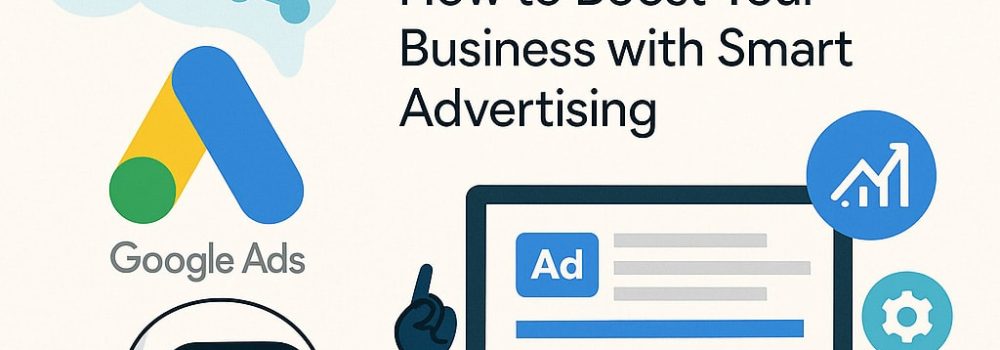Google Ads & AI: How to Boost Your Business with Smart Advertising
What Is Google Ads?
Google Ads is Google’s online advertising platform that allows businesses to promote their products or services across Google Search, YouTube, and partner websites. Advertisers can create targeted ads that appear when users search for relevant keywords, helping drive traffic, leads, and sales. Google Ads operates on a pay-per-click (PPC) model, meaning you only pay when someone clicks on your ad.
Key Features of Google Ads That Help Businesses Grow
- Targeted Reach: Show your ads to people actively searching for what you offer.
- Flexible Budgets: Set daily or monthly budgets with full control over your ad spend.
- Performance Tracking: Access detailed reports on clicks, impressions, conversions, and ROI.
- Multiple Ad Formats: Use search ads, display ads, shopping ads, video ads, and more.
- Local & Global Reach: Target customers by location, language, device, and demographics.
How AI Is Transforming Google Ads
Artificial Intelligence (AI) is at the core of Google Ads, powering many features that help advertisers achieve better results with less manual effort. Here’s how AI enhances your campaigns:
1. Smart Bidding
AI analyses millions of signals in real-time to automatically set the right bid for each auction, maximising conversions or return on ad spend (ROAS). This means you don’t have to manually adjust bids for every keyword or audience.
2. Responsive Search Ads
With AI, Google Ads can test multiple headlines and descriptions, automatically finding the best-performing combinations for each search query. This improves ad relevance and increases conversion rates.
3. Performance Max Campaigns
Performance Max uses AI to optimise your ads across all Google channels (Search, Display, YouTube, Gmail, and Maps) from a single campaign. AI determines the best placements, creatives, and audiences to help you achieve your goals. Businesses using Performance Max often see an increase in conversions without increasing costs.
4. Automated Targeting
AI analyses user behaviour, demographics, and intent signals to show your ads to people most likely to convert. This ensures your budget is spent efficiently and reaches the right audience at the right time.
5. Creative Generation
Google’s generative AI can suggest or create ad headlines, descriptions, and even images based on your website or landing page. This saves time and ensures your ads are always fresh and relevant.
6. AI-Powered Recommendations
The Recommendations tool in Google Ads uses AI to analyse your account and suggest optimisations like adding new keywords, improving ad strength, or adjusting bids to boost performance.
How to Use AI to Improve Your Google Ads Results
- Enable Smart Bidding: Choose automated bidding strategies like Target CPA, Target ROAS, or Maximise Conversions.
- Use Responsive Search Ads: Provide multiple headlines and descriptions; let Google’s AI find the best combinations.
- Try Performance Max: Consolidate your campaigns and let AI optimise across all Google channels.
- Leverage Recommendations: Regularly review and apply AI-powered suggestions in your account.
- Connect Your Data: Integrate first-party data (like customer lists) so AI can learn and optimise more effectively.
Why Google Ads + AI Is a Winning Combination for Businesses
- Improved Efficiency: AI automates complex tasks, saving you time.
- Better Results: Campaigns are continuously optimised for higher conversions and lower costs.
- Greater Insights: Access actionable data and recommendations to refine your marketing strategy.
- Competitive Advantage: Stay ahead with the latest AI-driven features and tools.
Google Ads, powered by advanced AI, offers businesses of all sizes a powerful way to reach customers, drive growth, and stay competitive in today’s digital landscape. By embracing AI features, you can maximize your advertising impact and achieve your business goals more efficiently than ever before.
Frequently Asked Questions: Google Ads And Ai
1. How does AI help small businesses compete with larger advertisers on Google Ads?
AI levels the playing field by automating complex tasks like bid management, audience targeting, and ad creative testing. This allows small businesses to optimise their campaigns efficiently, even with limited resources, and achieve results similar to those of larger competitors.
2. Can AI in Google Ads help reduce wasted ad spend?
Yes, AI analyses real-time data to identify which keywords, audiences, and placements are most likely to convert. By automatically adjusting bids and targeting, AI helps ensure your budget is spent on the most effective opportunities, reducing wasted spend.
3. What are some practical ways to start using AI features in Google Ads?
Begin by enabling automated bidding strategies, using dynamic ad formats, and reviewing the Recommendations tab for AI-driven suggestions. You can also experiment with new AI-powered campaign types as they become available.
4. Is it safe to rely on AI for ad creative, or should I still review and edit suggestions?
While AI-generated ad copy and images can save time and improve relevance, it’s always best to review and customise suggestions to ensure they align with your brand voice and marketing goals. Human oversight ensures quality and compliance.
5. How does AI in Google Ads adapt to changing market trends or consumer behaviour?
AI continuously learns from new data, adjusting targeting and bidding strategies in real time. This means your campaigns can quickly respond to changes in consumer interests, seasonal trends, or shifts in the competitive landscape, keeping your ads relevant and effective.

